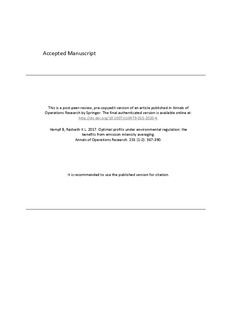| dc.contributor.author | Hampf, Benjamin | |
| dc.contributor.author | Rødseth, Kenneth Løvold | |
| dc.coverage.spatial | U.S.A | nb_NO |
| dc.date.accessioned | 2019-12-19T08:53:48Z | |
| dc.date.available | 2019-12-19T08:53:48Z | |
| dc.date.created | 2015-12-04T09:39:09Z | |
| dc.date.issued | 2015-09-22 | |
| dc.identifier.citation | Annals of Operations Research. 2017, 255 (1-2), 367-390. | nb_NO |
| dc.identifier.issn | 0254-5330 | |
| dc.identifier.uri | http://hdl.handle.net/11250/2634082 | |
| dc.description.abstract | In this paper we analyze the economic effects of implementing EPA’s newly proposed regulations for carbon dioxide (CO2) on existing U.S. coal-fired power plants using nonparametric methods on a sample of 144 electricity generating units. Moreover, we develop an approach for evaluating the economic gains from averaging emission intensities among the utilities’ generating units, compared to implementing unit-specific performance standards. Our results show that the implementation of flexible standards leads to up to 2.7 billion dollars larger profits compared to the uniform standards. Moreover, we find that by adopting best practices, current profits can be maintained even if an intensity standard of 0.88 tons of CO2 per MWh is implemented. However, our results also indicate a trade-off between environmental and profit gains, since aggregate CO2 emissions are higher with emission intensity averaging than with uniform standards. | nb_NO |
| dc.language.iso | eng | nb_NO |
| dc.publisher | Springer US | nb_NO |
| dc.rights | Attribution-NonCommercial-NoDerivatives 4.0 Internasjonal | * |
| dc.rights.uri | http://creativecommons.org/licenses/by-nc-nd/4.0/deed.no | * |
| dc.title | Optimal profits under environmental regulation: the benefits from emission intensity averaging | nb_NO |
| dc.title.alternative | Optimal profits under environmental regulation: the benefits from emission intensity averaging | nb_NO |
| dc.type | Journal article | nb_NO |
| dc.type | Peer reviewed | nb_NO |
| dc.rights.holder | © Springer Science+Business Media New York 2015 | nb_NO |
| dc.description.version | submittedVersion | nb_NO |
| cristin.unitcode | 7482,0,0,0 | |
| cristin.unitname | Transportøkonomisk institutt | |
| cristin.ispublished | true | |
| cristin.fulltext | preprint | |
| cristin.qualitycode | 1 | |
| dc.identifier.doi | 10.1007/s10479-015-2020-4 | |
| dc.identifier.cristin | 1296873 | |
| dc.source.journal | Annals of Operations Research | nb_NO |
| dc.source.volume | 255 | nb_NO |
| dc.source.issue | 1-2 | nb_NO |
| dc.source.pagenumber | 367-390 | nb_NO |

